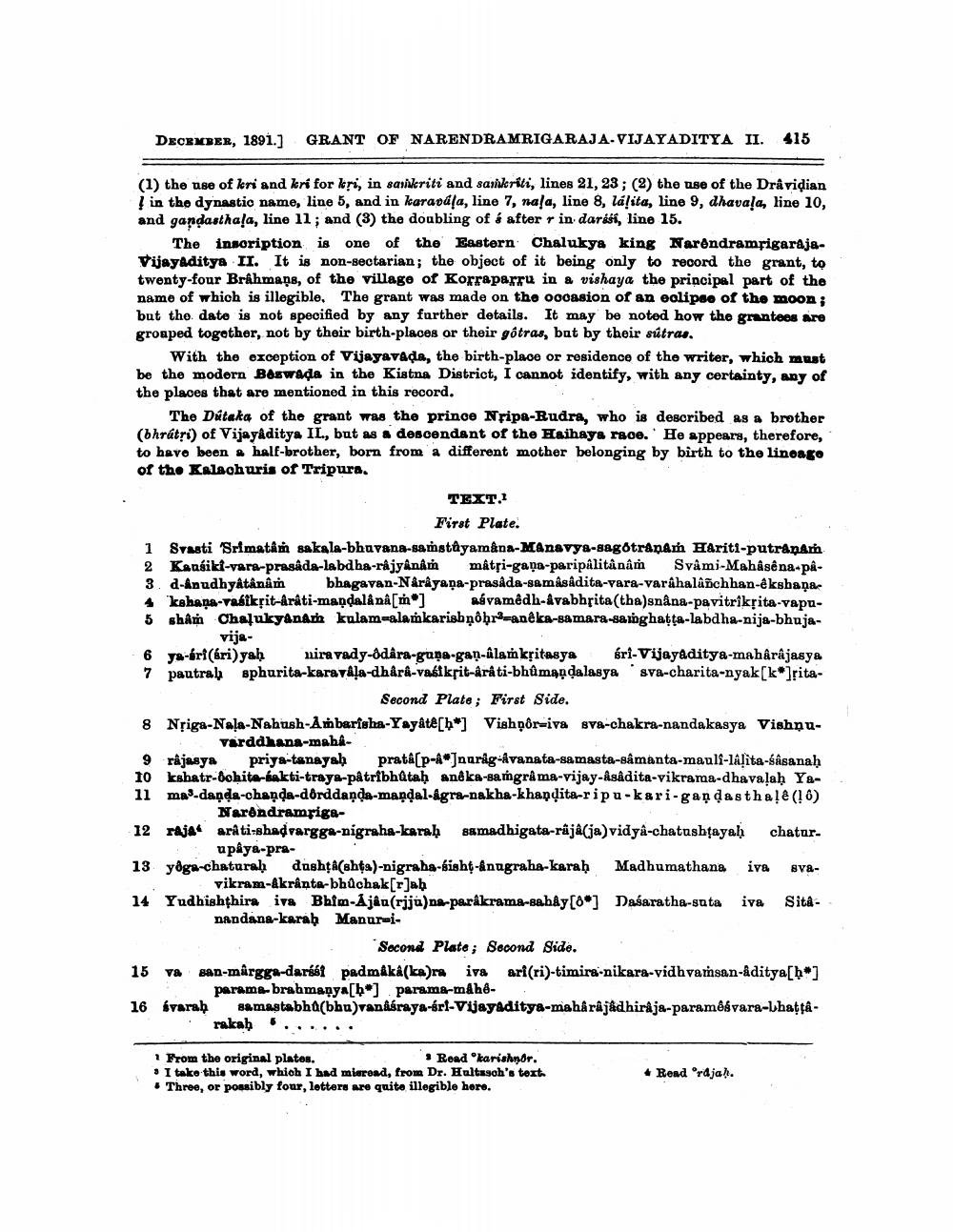________________
DECEMBER, 1891.) GRANT OF NARENDRAMRIGARAJA.VIJAYADITYA II. 415
(1) the use of krs and kri for kri, in sankriti and sankriti, lines 21, 23; (2) the use of the Dravidian Į in the dynastic name, line 5, and in karaokļa, line 7, nala, line 8, lalita, line 9, dhavala, line 10, and gardasthala, line 11; and (3) the doubling of á after r in darksi, line 15.
The insoription is one of the Eastern Chalukya king Narendramrigaraja. Vijayaditya II. It is non-sectarian; the object of it being only to record the grant, to twenty-four Brahmans, of the village of Korraparru in a vishaya the principal part of the name of which is illegible. The grant was made on the occasion of an eolipso of the moon; but the date is not specified by any further details. It may be noted how the grantees are groaped together, not by their birth-places or their gôtras, but by their sutra..
With the exception of Vijayavada, the birth-place or residence of the writer, which must be the modern Baswada in the Kistna District, I cannot identify, with any certainty, any of the places that are mentioned in this record.
The Dútaka of the grant was the prince Nripa-Rudra, who is described as a brother (bhrátri) of Vijayaditya IL, but as a descendant of the Haihaya race.' He appears, therefore, to have been half-brother, born from a different mother belonging by birth to the lineago of the Kalachuris of Tripura.
TEXT.
First Plate. 1 Svasti 'Srimatâm sakala-bhavana-samstâyamâna-Manavya-sagðtranAm Hariti-putranam
Kansiki-vara-prasada-labdha-rajyanam mâtsi-gana-paripálitânam Svami-Mahásê na-på3. d-Anudhyâtânâm bhagavan-Narayana-prasada-samásâdita-vara-varahalañchhan-êkshana4 kahana-Vabikțit-Aráti-mandalå nâ[m] dávamêdh-avabbrita(tha)snana-pavitrikrita-vapa5 sham Chalukyanan kulam-alamkarisbņôhraneka-samara-sainghatta-labdha-nija-bhuja
vija6 ya-éri(eri)yah nira vady-odara-guna-gan-alan kitasya sri-Vijayaditya-mahârâjasya 7 pautral sphurita-karaváļa-dhårå-vabikritârâti-bhûmapdalasya 'sva-charita-nyak[k*]rita
Second Plate; First Side. 8 Nriga-Naļa-Nabush-Ambarisha-Yayate[h*] Vishọôr=iva sva-chakra-nandakasya Vishnu
varddhana-maba9 râjasya priya-tanayah prata[p-A*Jaurág-ávanata-samasta-sâmanta-mauli-lAlita-sasanah 10 kshatr-Bohita-akti-trays-pâtribhůtah aneka-sangrå ma-vijay-Asâdita-vikrama-dhavalah Ya11 mai-danda-chanda-dörddanda-mandal-&gra-nakha-khandita-ripu-keri-gandastha!e (16)
Narendramriga12 rajet arkti-shadvargge-nigraha-keraḥ samadhigata-rajálja) vidyâ-chatashțayah chatur.
upya-pra13 yoga-chaturaḥ dashtå(shta)-nigraha-sisht-anugraha-karaḥ Madhumathana iva sva
vikram-akranta-bhûchak[rjah 14 Yudhishthira iva Bhim-Aján(rjju)na-paråkrama-sabây[] Dasaratha-sata iva Sitanandana-karab Mandrei
Second Plate ; Second Side. va san-märgga-darási padmáka(ka)ra iva ari(ri)-timira-nikara-vidhvamsan-aditya[h*]
parame-brahmanya[bo] parama-mahd16 svarah samastabha(blu)vankáraya-érl-Vijayaditya-mahårájádhiraja-paramêsvara-Whatta
rakah 6......
? From the original plates.
Read karishnor. • I take this word, which I had misread, from Dr. Hultasoh's text • Three, or possibly four, letters are quito illegible here.
* Read Prdjah.




